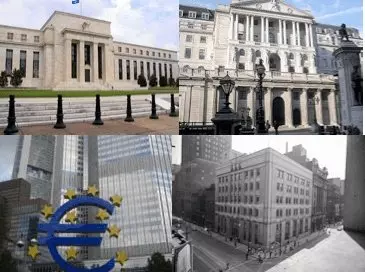Comments
- No comments found

“The constant refinancing of debt from companies of doubtful viability also leads to the perpetuation of overcapacity because a key process for economic progress, such as creative destruction, is eliminated or limited”.

One of the arguments most used by central banks regarding the increase in inflation is that it is because of bottlenecks and that the recovery in demand has created tensions in the supply chain. However, the evidence shows us that most commodities have risen in tandem in an environment of a wide level of spare capacity and even overcapacity.
If we analyse the utilization ratio of industrial and manufacturing productive capacity, we see that countries such as Russia (61%) or India (66%) are at a clear level of structural overcapacity and a utilization of productive capacity that remains still several points lower than that of February 2020. In China it is 77%, still far from the 78% pre-pandemic level. In fact, if we analyse the main G20 countries and the largest industrial and commodity suppliers in the world, we see that none of them have levels of utilization of productive capacity higher than 85%. There is ample available capacity all over the world.
Inflation is not a transport chain problem either. The excess capacity in the shipping and transport sector is more than documented and in 2020 new capacity was added in both freights and air transport. Ships delivered in 2020 added 1.2 million twenty-foot equivalent units (TEUs) of capacity, with 569,000 TEUs of capacity on ultra large container vessels (ULCV), ships with capacity for more than 18,000 TEUs, according to Drewry, a shipping consulting firm. International Air Transport Association (IATA) chief economist Brian Pearce also warned that the problem of capacity was increasing in calendar year 2020.
One of the important side effects of the chain of monetary stimuli, low interest rates and fiscal stimulus programs is the increase in the number of zombie companies. The BIS (Bank for International Settlements) has shown this phenomenon in several empirical studies. Ryan Banerjee, senior economist at the BIS, identified the constant policy of lowering rates as a key factor in understanding the exponential increase in zombie companies, those that cannot cover their debt interest bills with operating profits. The constant refinancing of debt from zombie companies also leads to the perpetuation of overcapacity, because a key process for economic progress, such as creative destruction, is eliminated or limited. Low interest rates and high liquidity have perpetuated or increased global installed excess capacity in aluminium, iron ore, oil, natural gas, soybeans and many other commodities.
Why does inflation rise if overcapacity is perpetuated and there is enough transport capacity?
We have forgotten the most important factor, the monetary one, or some central banks want to make us forget it. “Inflation is always and everywhere a monetary phenomenon,” explained Milton Friedman many decades ago. More supply of money directed towards scarce assets, be it real estate or raw materials. The purchasing power of money goes down.
Why did they tell us that there was “no inflation” before COVID-19 if money supply increased also massively?
The big difference between 2020 and the past years is that previously, the Federal Reserve or the ECB increased money supply at or below the levels of demand for money (measured as demand for credit and use of currency). For example, the increase in the money supply of the United States was close to 6% with a global demand for dollars that grew between 7 and 9%. In fact, the world maintains a dollar shortage of about $ 17 trillion, according to Luke Gromen of Forest for the Trees. This keeps the dollar or euro relatively stable and a perception that inflation is low. However, there were red flags before Covid-19. There were protests all over the world, including Europe, against the rising cost of living. The world’s reserve currencies export inflation to other countries.
What happened in 2020?
For the first time in decades, the Federal Reserve, and the main central banks increased money supply well above demand. The response to the forced shutdown of activity with massive money printing generated an unprecedented inflationary wave. The economy did not collapse due to lack of liquidity or a credit crunch, but due to the lockdowns.
The 2020 monetary tsunami launched a global boomerang effect with three consequences: Emerging market currencies plummeted against the dollar because their central banks “copied” the U.S. policy without the global demand that the U.S. dollar enjoys. The second effect was a disproportionate amount of money flowing to risky assets joined by more flows to take overweight positions in scarce assets. That excess money made investors move from being underweight in commodities to overweight, generating a synchronized and abrupt rally. The third key factor is that extraordinary measures typical of a financial or demand crisis were taken to mitigate a supply shock, generating an unprecedented rise in money with no added credit demand. More money in scarce assets is not a price increase, but a decrease in the purchasing power of money.
What is the risk?
The history of money since the Roman Empire always tells us the same thing. First, money is aggressively printed with the excuse that “there is no inflation.” When inflation rises, central banks and governments tell us that it is “transitory” or due to “multi-casual” effects. And when it shoots up, governments present themselves as the “solution” imposing price controls and restrictive measures on exports. It is not a theory. All of us who have lived in the seventies know it.
That is why it is dangerous to pursue conglomerate stocks as an inflationary bet… Because when price controls and government intervention increases, margins collapse.
The risk of stagflation is not small, and the so-called value stocks are not a good bet in this environment. In stagflation, commodities with tight supply dynamics, gold and silver, high margin sectors and bonds of stable currencies support a portfolio. However, most sectors underperform as we saw in the 70s, where the S&P 500 generated very weak returns, significantly below inflation.
What can be different from other episodes?
Only a drastic reaction from central banks can change it. However, the question is:
Will central banks tighten their policy when government deficits are soaring? Even a small increase in sovereign yields can generate a debt crisis.
Will they react to what is clearly — as always — a monetary inflationary process?
Daniel Lacalle is one the most influential economists in the world. He is Chief Economist at Tressis SV, Fund Manager at Adriza International Opportunities, Member of the advisory board of the Rafael del Pino foundation, Commissioner of the Community of Madrid in London, President of Instituto Mises Hispano and Professor at IE Business School, London School of Economics, IEB and UNED. Mr. Lacalle has presented and given keynote speeches at the most prestigious forums globally including the Federal Reserve in Houston, the Heritage Foundation in Washington, London School of Economics, Funds Society Forum in Miami, World Economic Forum, Forecast Summit in Peru, Mining Show in Dubai, Our Crowd in Jerusalem, Nordea Investor Summit in Oslo, and many others. Mr Lacalle has more than 24 years of experience in the energy and finance sectors, including experience in North Africa, Latin America and the Middle East. He is currently a fund manager overseeing equities, bonds and commodities. He was voted Top 3 Generalist and Number 1 Pan-European Buyside Individual in Oil & Gas in Thomson Reuters’ Extel Survey in 2011, the leading survey among companies and financial institutions. He is also author of the best-selling books: “Life In The Financial Markets” (Wiley, 2014), translated to Portuguese and Spanish ; “The Energy World Is Flat” (Wiley, 2014, with Diego Parrilla), translated to Portuguese and Chinese ; “Escape from the Central Bank Trap” (2017, BEP), translated to Spanish. Mr Lacalle also contributes at CNBC, World Economic Forum, Epoch Times, Mises Institute, Hedgeye, Zero Hedge, Focus Economics, Seeking Alpha, El Español, The Commentator, and The Wall Street Journal. He holds a PhD in Economics, CIIA financial analyst title, with a post graduate degree in IESE and a master’s degree in economic investigation (UCV).
Leave your comments
Post comment as a guest